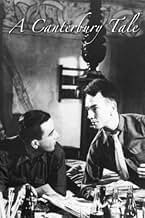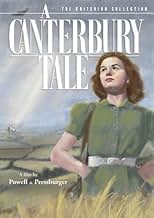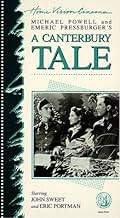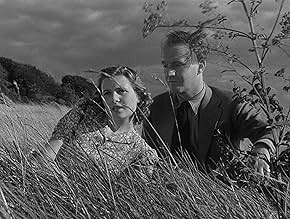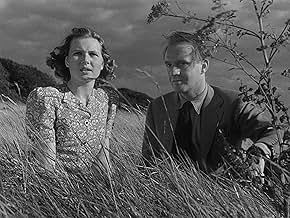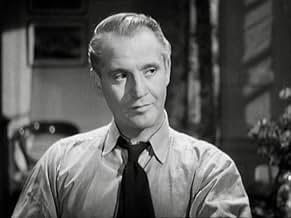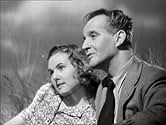Aggiungi una trama nella tua linguaThree modern-day pilgrims investigate a bizarre crime in a small town while on their way to Canterbury.Three modern-day pilgrims investigate a bizarre crime in a small town while on their way to Canterbury.Three modern-day pilgrims investigate a bizarre crime in a small town while on their way to Canterbury.
- Regia
- Sceneggiatura
- Star
- Sergeant Bob Johnson
- (as Sergt. John Sweet U.S. Army)
- Sergt. Bassett
- (as Antony Holles)
Recensioni in evidenza
First -- I loved the camaraderie that developed immediately among all the ordinary folks thrown together and forced to work as teammates for the common cause. (If war is good for anything, it must be that.) Second -- I liked the tall skinny American soldier and the difficulties and simple pleasures he found among the Brits -- I've been there, done that, and P&P captured the feeling very nicely. (Note: Bob Johnson's accent is quite authentic for a rural Oregonian, so stop complaining, you funny Commonwealth lot!). Third -- I enjoyed every minute that Sheila Sim was on camera. Finally -- that cut in the prologue, from the hawk to the fighter plane, was excellent indeed. (And yes, I'd bet my piggy bank that Stanley Kubrick got his idea for the bone-to-space station cut in 2001 from this very film.)
But wait, I realize that I do have to register one last complaint. I love black & white movies, so much that whenever I hear twentysomething kids whine that they can only watch movies in color, I am nauseated. And yet -- I wager that any filmmakers who purport to represent the beauty of the Kentish countryside on a summer day will truly achieve their goal only if they film in color. England's green and pleasant land just can't be painted in shades of gray.
The photography is geared towards presenting the glory of the English countryside, and beautifully conveys an England which was fast disappearing by the time war broke out. Watch especially for the shots of Alison on the downs just after looking towards Canterbury. Gorgeous!
You will either love or hate this film, but you MUST see it if you have not already done so. I've just bought it on DVD, and am ditching various copies taped from TV over the years.
PS: If anyone with any influence at Carlton reads this, please urgently consider transcribing "I Know Where I'm Going" - another fine Powell/Pressburger movie - onto DVD.
The plot, such as it is, is bizarre. A small village in Kent is being terrorised by a madman who puts glue in women's hair during the blackout. The GI, the Sergeant and the Land Girl resolve to find the culprit.
All roads lead to Canterbury, where the Cathedral oversees the resolution of the mystery and of the disappointments in the characters' lives, before the soldiers set off on a more dangerous pilgrimage.
In the end, the plot is unbelievable, the character of Culpepper the magistrate unfathomable, the symbolism of the Cathedral laid on with a trowel - yet, why is this such a satisfying film? I think that there is a spirit which shines through this film - an optimism, a determination. The Land Girl has lost her Pilot fiancée, she grieves yet she is not downhearted. The GI loves and misses his homeland but can compare timber preparation techniques with the local blacksmith and find commonality. The English Countryside is ravishing throughout.
This film subtly highlights the values being fought for, the personal values, the village way of life, the spirit exemplified by the history of the Canterbury Pilgrims and of the Cathedral itself. And it is by tapping into the British psyche so deeply that even today it resonates which makes it a great film.
The only word I can find to give a flavour of this story is that it is above all English - as English as Ealing comedy (without the comedy), as Miss Marple (without the murder), as Elizabeth Goudge (without the magic)... and yet again I find myself defining it by what it *isn't*! It's English in a way that is quietly, deeply antithetical to the frenetic posturing of 'Cool Britannia'. It is as English as the haze over the long grass beneath the trees of a summer meadow; as polished brass and a whiff of steam as the express pulls up at a country halt; as church bells drifting in snatches on a lazy breeze, and the taste of blackberries in the sun.
It's almost impossible now to comprehend that the 1940s countryside in which this film is set was *really there*; that it was not the Second World War but its crippling aftermath that industrialised farms, banished the horse-drawn vehicles from the wheelwright's, and exchanged towering hay-wains for silage towers. Britain was determined never to starve again - and so the world that had once differed so little from that of Chaucer's time was swept away beyond recall. When it was made, this film was no more a rustic period piece than 'Passport to Pimlico', a few years later, was an urban social documentary. Subsequent events have preserved both in mute evidence of contemporary communities that are almost unbelievable today.
It is perhaps fair, therefore, to assume that the type of viewer who will watch 'Battlefield Earth' is unlikely to find this film anything other than silly, parochial and ultimately dull! Very little actually happens. The story is on occasion both humorous and poignant, but what we at first assume to be the central plot turns out not to be the point at all. The triple denouement is set up so gently and skilfully that we, too, are taken by miraculous surprise, with the true shape of the film only evident in retrospect.
It is, ultimately, a story about faith, and miracles, and pilgrimages, even in the then-modern world of shopgirls, lumbermen and cinema organists - and if that idea in itself sounds enough to put you off, as I confess it would have done for me before I watched it myself, then I will gladly add that it is a film about beauty, and hope, and unexpected friendship and laughter; and technically very accomplished to boot. The use of black and white is glorious, ranging from the glimmer in the obscurest of shadows to sun-drenched hillside, and the totally unselfconscious reference to Chaucer in the opening sequence is in these days worth the price of admission alone.
If you like gentle films - sweet-natured films - films with a deep affection for their subject - films that make you laugh and cry, but always smile - then I urge you not on any account to miss this one. If, for the moment, you require thrills, spills, forbidden passions and last-minute rescues, then pass it by and let it go on its tranquil way. When you are old and grey and full of sleep, this unassuming classic will still be there, waiting...
Lo sapevi?
- QuizThe Archers (Michael Powell and Emeric Pressburger's production company) weren't given permission to film inside Canterbury Cathedral. In any case, the stained-glass windows had been taken out because of the air raids, the aisles were filled with sandbags and earth to fight fires and to provide a soft landing for any masonry or sculptures that fell there. So the interior of the Cathedral was rebuilt in Denham Studio. They recreated it so well that Cathedral guides have been heard telling people that the film was shot in there.
- BlooperA camera operator's shadow is clearly visible while Alison is riding a horse and buggy along the pilgrim's road.
- Citazioni
Thomas Colpeper, JP: Well, there are more ways than one of getting close to your ancestors. Follow the old road, and as you walk, think of them and of the old England. They climbed Chillingbourne Hill, just as you. They sweated and paused for breath just as you did today. And when you see the bluebells in the spring and the wild thyme, and the broom and the heather, you're only seeing what their eyes saw. You ford the same rivers. The same birds are singing. When you lie flat on your back and rest, and watch the clouds sailing, as I often do, you're so close to those other people, that you can hear the thrumming of the hoofs of their horses, and the sound of the wheels on the road, and their laughter and talk, and the music of the instruments they carried. And when I turn the bend in the road, where they too saw the towers of Canterbury, I feel I've only to turn my head, to see them on the road behind me.
- Versioni alternativeThe original UK version runs 124 minutes. For the USA release, the film was re-edited to 95-minutes and new footage starring Kim Hunter inserted:
- A scene between Bob (John Sweet) and his new bride Kim Hunter on the Rockefeller Center introduces the story which he then tells in flashback.
- The idyllic scenes with the boys' river battle and much of the hunt for the glue-man is cut with addition scenes or commentary by Bob added to cover the gaps.
- There is an additional epilogue with Bob and his girl at the tea-rooms in Canterbury.
- ConnessioniFeatured in Arena: A Pretty British Affair (1981)
- Colonne sonoreAngelus ad Virginem
(uncredited)
Traditional
Heard as a peal of bells in the opening titles
I più visti
- How long is A Canterbury Tale?Powered by Alexa
Dettagli
- Data di uscita
- Paese di origine
- Lingua
- Celebre anche come
- Un cuento de Canterbury
- Luoghi delle riprese
- Selling, Kent, Inghilterra, Regno Unito(Railway station and signal box)
- Aziende produttrici
- Vedi altri crediti dell’azienda su IMDbPro
Botteghino
- Budget
- 650.000 USD (previsto)
- Lordo in tutto il mondo
- 15 USD
- Tempo di esecuzione2 ore 4 minuti
- Colore
- Proporzioni
- 1.37 : 1
Contribuisci a questa pagina



